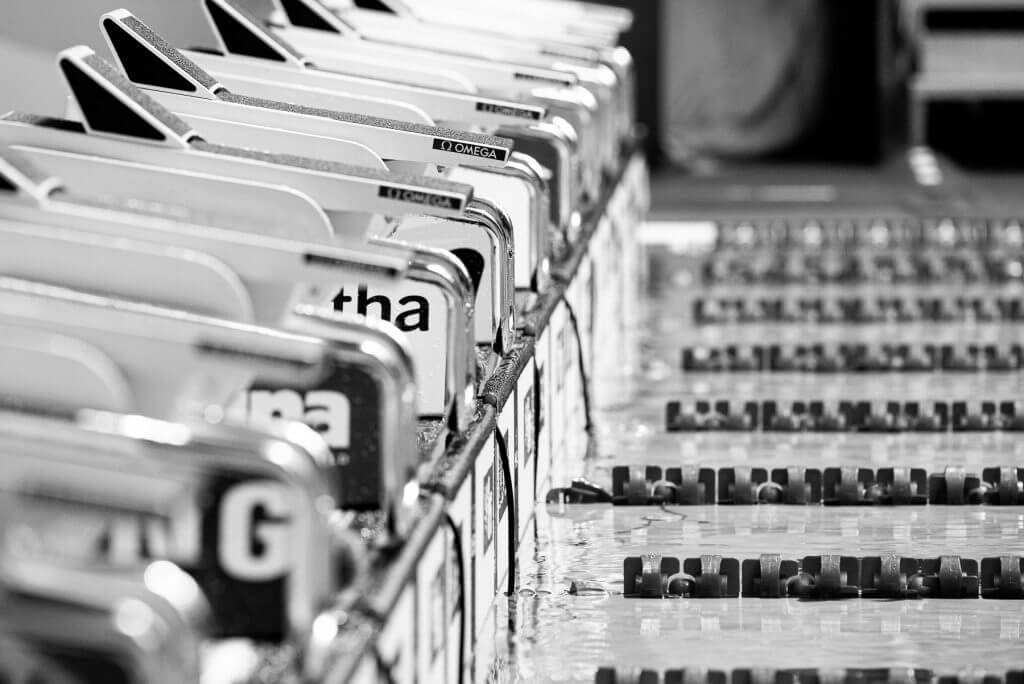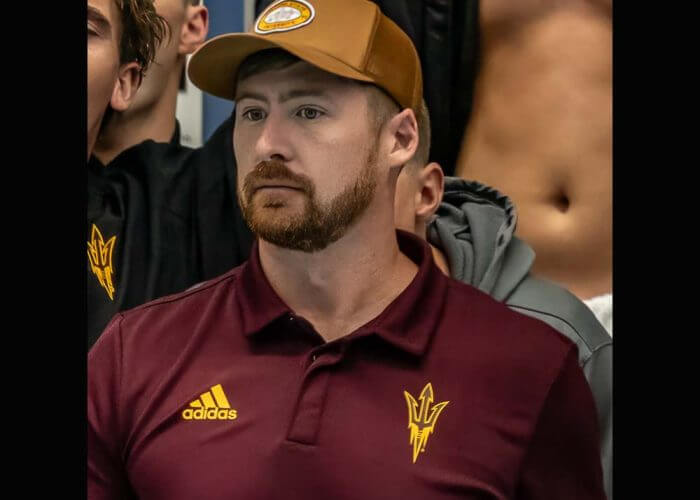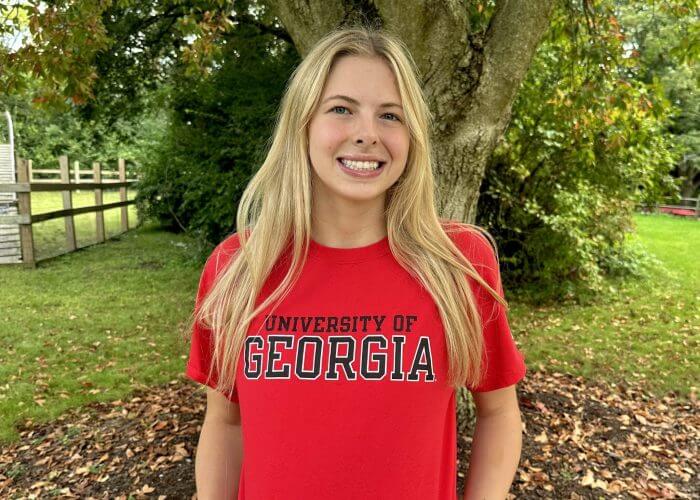Swim Training for 50s: A Look at Different Approaches to Sprinting

Swim Training for 50s: A Look at Different Approaches to Sprinting
Earlier in his career, the high school coach sought the secret to speed—especially fast 50s. As a high schooler, he had a teammate ultimately go a 22.4 50 free (nation’s third fastest in 1960). Later on he watched Katie Ledecky, at age 12, split a 25.75 fly leg and Caeleb Dressel drop a 17.63 50 free.
He also read and talked to Dave Salo about race-pace training, conversed with Brent Rushall and Peter and Michael Andrew about USRPT, all in search of a final answer. In time, he had a breaststroker set a state record in the 50 freestyle and two girls win eight straight 500 free titles, but never really found the magic bullet.
Surprise, Surprise

Photo Courtesy: Peter H. Bick
Turns out, there may not be one. In a recent ASCA presentation, Herbie Behm, Arizona State head man and renowned sprint coach, and Tim Hill, former college mentor and now age group coach with Sharks Swim Team in Friendship, Texas, debated the characteristics of sprint versus distance training.
“We’re living through the sprint revolution,” noted Behm. “The fact is the human adaptation process starts at birth.” The two agree that once swimmer periodization – or organized change – begins, sprinting is all about training the nervous system, particularly the sympathetic nervous system which prepares the body for strenuous physical activity.
At the same time, there remains a need to train the parasympathetic system which aims to bring the body to a calmer state. To a swimmer or coach this translates to lower intensity training and recovery. Keeping long-term swimmer development in mind you’ve got to develop both, they say, applying appropriate amounts of aerobic and anaerobic exercise while providing opportunities in all four strokes for mental and physical recovery.
What Now
Swimming World recently queried coaches about the training they provide their quicker athletes. To no great surprise, they identified similar training characteristics:
- No sprint training groups per se, but lots of opportunities for fast swimming
- Emphasis on technique
- Lots of kicking
- Speed and power work
RMSC
The Rockville Montgomery Swim Club (Maryland) has been producing champions for years (think Texas’ Jack Conger and Eric Friedland, Michigan’s Mike Barrowman, Princeton’s Dan Veatch, Stanford’s Sarah Haase). In March, RMSC swimmers rocked the house at Spring NCSA juniors. Among the star-studded cast that senior coaches Mark Eldridge and Akshay Gandhi took were college committed National Training Group swimmers Amy Qin (Penn), Sarah Eliason (BYU) and Elliot Lee (Yale).
“We definitely don’t have a ‘50’s’ or even really a ‘sprint’ group,” says Eldridge “but we’re certainly proud of the group’s ability to get up and race while implementing technique and tempo levels that we’ve worked on. We do, however, believe in giving athletes opportunities to race 25s and 50s hard and fast in practice off the blocks with adequate rest. It’s not a daily occurrence as our athletes are still 14-18 and because we are developing their swimming skills across all four strokes and many distances. We allow time and space for short-distance specific training just as we allow time and space for longer-distance training. All three have cited this approach as something that has helped them prepare to race the shorter distances.
“We do not do anything specific or revolutionary to swim sprint free, fly, back or breast,” says Gandhi. “We do focus deeply on POWER and TEMPO. Stroke-counts, tempo-trainers and short-distance power pulling are all aspects of developing our athletes. We spend a considerable amount of time working on pushing off the walls well and on underwater dolphin kicking. We’ve more recently been adjusting our free and back turns to have a more prominent head-lead into the flip.
“Having a few fast-twitch swimmers does help team speed, but the reality is most of our swimmers are not incredibly gifted (or gifted at all) as far as height or limb length. We try to address speed through maximal length of stroke, start, underwater and off turns.”
“Our National Training Group swimmers benefit greatly from the technical foundation acquired in our age group program. As a team we are disciplined regarding body position, form and especially all aspects of kicking for power and speed,” says Eldridge.
Notes Gandhi: “We like to keep workouts fresh and get creative, throwing in tweaks and adjustments based on the day, rarely repeating sets over the course of the season.”
One staple is something like:
3 rounds:
1 x 25 Sprint off blocks ending with a turn on 1:00
1 x 50 Sprint starting with a turn, ending with a finish on 1:30
1 x 75 Sprint starting with a turn, ending with a finish on 2:00
Recovery 200
Sarah Eliason has been swimming with RMSC since 2017. In Orlando, she finished third in the 50 LC butterfly (27.76), clocking team records in the 17-18 and Open categories. “I thought doing 50s off the blocks, working on turns and working on arm tempo was especially helpful,” she says of her RMSC training.
Elliot Lee credits his 25.81 14th place finish in his 50 fly final‘s “to working on underwaters, racing and regular over-distance off the blocks (75s and 125s).”
Amy Qin began swimming with RMSC 11 years ago and currently holds 12 team (10 SCY, 2 LCM) records, primarily in sprints, fly and back. She attributes her success to RMSC’s “positive atmosphere where 50s are important along with dryland, strength, core work and underwater discipline.”
“There’s no magic pill here,” says Eldridge, “just disciplined athletes who work hard to get better in an environment of support and enjoyment.”
Foxjets
Lloyd Larsen is head coach of Foxjets Swim Team, a USA Swimming Bronze Medal club in Eden Prairie, Minnesota. He is also father of daughter Caroline, the state’s number one ranked recruit in the class of 2024 (19th nationally), committed to the University of Louisville.
Caroline is also a National Junior Team member who finished fifth in the 50 free (25.26) at September’s World Juniors meet in Israel. This past year, Caroline has been lights out. At NCSA’s in March she won the 50 fly (26.75, state record) and 100 fly (59.75) and placed second in the 50/100 free (25.33/55.86) and 50 breast (31.86) and third in the 100 breast (1:12.39). At December’s Speedo Winter Junior Championship West, she went a state record 21.93 in the 50 freestyle and placed second in the 100 fly (52.15) and third in the 100 breast (1:00.07).
Coach Larsen attributes excellence in the shorter distances to “plenty of recovery and overspeed work for all distances 50/100/200. We train for speed pace at every distance – not USRPT, but sustainable race pace, recorded with specific objectives. We do have several highly talented/fast twitch swimmers but they all benefit from this sort of training.”
One secret is Foxjets’ foundational training that starts with age groupers. “It is very technique-oriented, all four strokes, with lots of kicking early and often. Kids swim all distances in meets through age 14. We also have a heavy emphasis on stroke rate and underwater kicking, which starts in earnest at 13,” says Larsen.
One set for 50 yards pace that seems to work well for his swimmers is:
4 Rounds through — Rd 1 Fly, Rd 2 Bk, Rd 3 Br, Rd 4 Fr
3 x 25 Race Pace — Rest 20 secs at each wall (first 25 from the blocks)
— after subtracting the broken rest, get 75 time, multiply by .667 to get a theoretical 50Y race time
1 x 125 Recovery
Each Round is on 5:00
Mission Viejo Nadadores
Logan Redondo is a lifer and head senior coach at MVN. He swam under the legendary Bill Rose, worked with Mark Schubert, was a CIF champion, two-time Olympic Trials qualifier and four-year swimmer at the University of Minnesota. He admits that the training done today looks very different than his time as an athlete.
“While our focus at MVN isn’t necessarily on exceling in the 50s, we do make it a point to offer different training opportunities for our athletes. We are not a one size fits all program. There are times in the season where we break off into stroke specialty groups. There are other times where we separate into different aerobic groups catered towards distance, middle distance and sprint. At times we train a sprint group specifically separate from our 200 & up athletes.
“A key focus for all our senior athletes,” says Redondo, “is on relays. It is something all our athletes prioritize whether they are the best sprinters or not. We want all our athletes focused on, and training for them, as it is a great way to foster a team and championship focus.
“We are very fortunate to have the facility and staff which helps us optimize our speed and power with all our athletes. Our strength coach and overall dryland program works very closely with what we are doing in the water. A huge factor in our improvement in our shorter distances and relay successes has come from the weight room. We work very closely with our strength coach on optimizing our season plan when working through strength and power phases. This is something that has helped our athletes tremendously not just in sprint swims but in body awareness, starts and turns,” says Redondo.
“We are very fortunate to have power towers, drag sox and other resistance equipment. These tools are built into our weekly program. Our athletes sprint under resistance in all four strokes each week which certainly aids in developing their speed and power throughout the season.
“At the Nadadores we have created a culture of striving for excellence and competing together on a regular basis. We prioritize some sort of sprint efforts in every single workout. We don’t always sprint for long periods, but we dedicate time every workout to a specific skill and then sprint with it – whether it be from the blocks, running starts, deadstarts, turns or push. We ultimately do some sort of top end speed efforts in every workout. These efforts can be as simple as three or four cycles. I have moved away from always going specific distances for sprints as I find their efforts stay closer to max when it is focused on cycles and power versus distance and time. This doesn’t mean we don’t do timed distances, but they are not as frequent as previously. The focus is more so on details and cycles unless the set specifically calls for it.
“In line with sprinting every day, we prioritize simple body awareness and foundational drills in almost every workout. We want all our athletes comfortable in the water with a strong understanding of their bodies and how they move,” he says.
Some MVN sprint & towers sets
Towers 3 Rounds
4×25’s 1:20 – Goal is to add weight each week and stay in same time
Extra :70 – Drop Belt
4×25’s :30 – Best Possible Average – Goal is faster avg than previous week
4:00 – Active Recovery
Sprint Capacity – 3 Rounds
4×25’s :30 – Fast as Possible Holding Same Stroke Count & Tempo
Extra :30 – Add Towers
2×15’s 1:15 – Heavy Sprint on Towers – Over 100% – Goal is to Hold Same Connection to Water
1×75 From Blocks – Open – Treat it like a 50 – Hold details last 25
EZ 100 Between Rounds
Sprint & Skill Examples
Skill Work/Activation 2 Rounds
2×50’s 1:10 – 25 Fist Drill/25 Build – with Sox
Extra :10 – Drop Sox
2×50’s – 1:00 – 15 Fast Hand Scull into 20 Fast DPS – EZ 15
2×50’s 1:10 – 5 Cycle Sprint!
1×100 2:40 – From Blocks – 35 Fast DPS – 65 EZ
Sprint Skill Focused – 2 Rounds
4×25’s :40 – UH20 – Switch Sides by 25 – Big Kicks
3×50’s 1:00 – 20 Build + Sprint Turn & 3 Cycles
4×25’s :35 – Odd’s: 4 Cycles Fast DPS – Power Focused Even’s: 2 Push Offs + 3 Cycle Sprint
1x Dirty 30 from Blocks – 15 Sprint Swim/15 UH20 Sprint – 1:30
2×25’s – 1 From Blocks – Sprint 2: Deadstart – Sprint 15 1:00
Academy Bullets
 The Aurora, Illinois-based Academy Bullets are a formidable presence at the annual NCSA Spring Championships. This year, they won the girls’ title with 1045.5 points and finished fifth in the combined standings with no contribution from boys. Leading the onslaught were the state’s second, third and fourth ranked girls according to Swimcloud. Versatile Becky Rentz (Notre Dame), Elizabeth Nawrocki (UGA) and Chloe Diner (Illinois) had a boatload of top eight finishes to boost the Bullets.
The Aurora, Illinois-based Academy Bullets are a formidable presence at the annual NCSA Spring Championships. This year, they won the girls’ title with 1045.5 points and finished fifth in the combined standings with no contribution from boys. Leading the onslaught were the state’s second, third and fourth ranked girls according to Swimcloud. Versatile Becky Rentz (Notre Dame), Elizabeth Nawrocki (UGA) and Chloe Diner (Illinois) had a boatload of top eight finishes to boost the Bullets.
Head senior coach Todd Capen claims his team doesn’t do many things differently from other teams in regard to sprint preparation. It’s quality swimming with a “distinct” purpose, he says. “We are blessed to have highly motivated athletes that love to compete day in and day out. They truly believe that the way they practice is the way they will perform. Every repeat. Every set. Every workout matters – and everybody buys in.
“We don’t train for the 50 or really even the 100. We focus the bulk of our training on IM and developing well-rounded swimmers. Bill Schalz constantly preached to me that a 200 freestyler can learn to swim a 50 and a 100. It is much easier to go down in distance than up. When we do break out in specialty groups we swim at race pace stressing good technique.
“We establish good technical swimming at our youngest ages and reinforce the basics, adding new wrinkles and details as swimmers grow and understand the strokes. We do small sets throughout the week aimed at developing speed. We use our bucket system (similar to power rack) two days per week for 20-25 minutes just working on resistance training in 10 second bursts maintaining proper technique and race pace tempo. Weight and rest intervals vary depending on time of season. We do a lot of kicking — all done fast.”
Below are some Bullet sets that focus on race pace speed, for stroke and IM.
IM Sprint Set 1: 4-6 RDS depending on day or athlete
1x 50 Fly Moderate @ :45
1x 50 Back Strong @ :40
1x 50 Breast FAST @ :35 or :40 -> depending on athlete
1x 50 Free Fast @ :30 -> finish hard
Rest :30
IM Test Set: 10x 100 @ 2:00
We start this set with athletes beginning at ages 11-12. It allows them to track their progress throughout the program and see improvements month-to-month and year over year. The 10 100’s are broken as follows: 1 fly, 2 back, 3 breast, 4 free. Every :01 over 1:00 is a point. Every second under 1:00 is -1 point. Goal is to get the lowest score you can.
Primary Sprint Set 1: Buckets Primary Stroke (4 RDS)
2x 25 @ 1:00 with heavy weight (12.5 AOS*, 12.5 smooth back to wall)
2x 50 @ 1:30
– #1 – All Fast (resistance on the way down, assistance on the way back)
– #2 – 25 AOS (resistance); Rest :10; 25 AOS Free No Breath (assistance)
* All Out Sprint
Primary Sprint Set 2: 8 RDS @ 5:00 (8 broken 100’s)
1x 50 from a dive AOS (all out sprint) at 1/2 100 time plus :01
Rest :20
2x 25 @ :30 AOS -> 15m underwater on both at race pace
Primary Sprint Set 3: 4 RDS
4x 50 @ 3:00 AOS
1x 200 @ No Interval between sets of 4
Goal of RD 1&2 is at 1st 50 of 100 Time
RD 3&4 are with short blade fins under best 50 Time




Love the sets, send more for strokes.